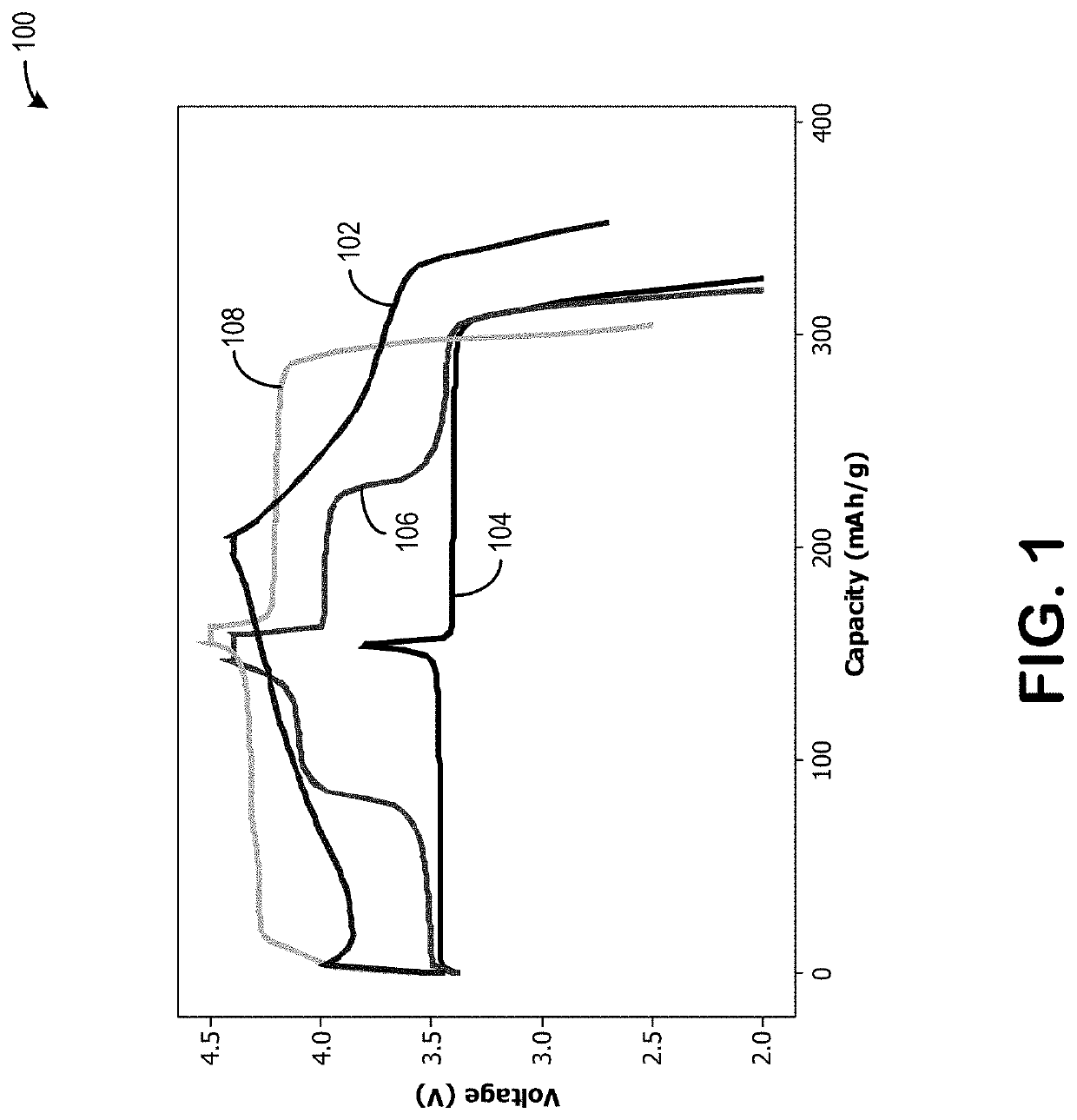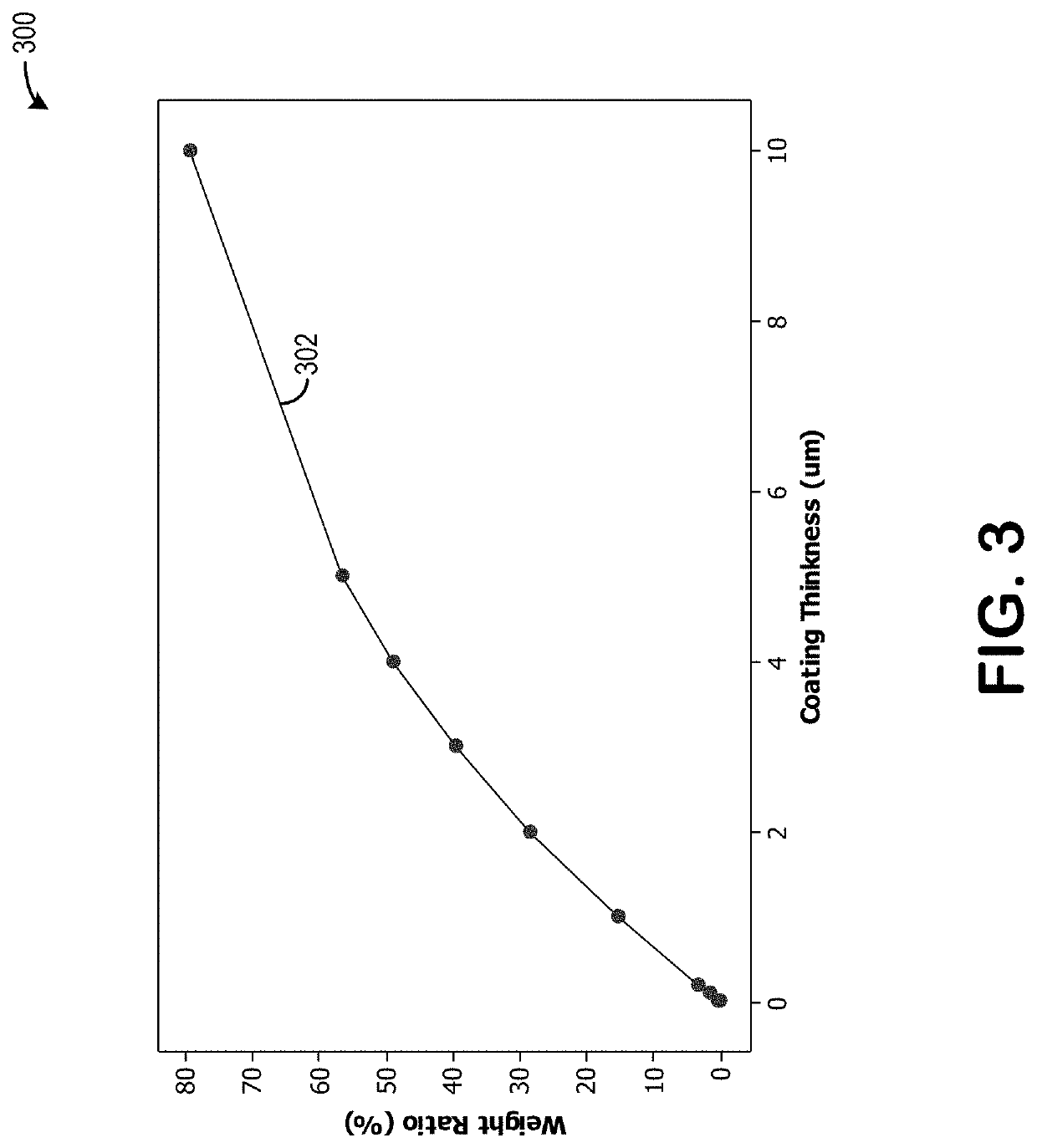Method and systems for coated cathode materials and use of coated cathode materials
- Summary
- Abstract
- Description
- Claims
- Application Information
AI Technical Summary
Benefits of technology
Problems solved by technology
Method used
Image
Examples
embodiment 200
[0041]Turning now to FIG. 2A, it shows an embodiment 200 of a cathode material 202 surrounded by a coating 204. The cathode material 202 may be a NCM cathode material comprising a composition of LiaNixMnyCo1-x-yDzO2, wherein 1.0≤a≤1.10, 0.1≤x≤0.9, 0≤z≤0.05, x+y+z=1, and D may be selected from a group consisting of Al, Zr, Mg, Sc, Fe, V, or Nb. Additionally or alternatively, the cathode material 202 may be a NCA cathode material comprising a composition of LiaNixCOyAl1-x-yDzO2, wherein 1.0≤a≤1.10, 0.1≤x≤0.9, 0≤z≤0.05, x+y+z=1, and D is selected from the group consisting of Al, Zr, Mg, Sc, Fe, V, or Nb.
[0042]The cathode material 202 may comprise a surface, or exterior surface, comprising one or more pores 208 and / or craters 208 and / or divots 208 and / or protrusions 208 and / or interstices 208, thereby increasing a surface area of the cathode material 202. As described above, contact between an electrolyte and the cathode material 202 may release one or more vapors, which may degrade a b...
embodiment 225
[0071]Turning now to FIG. 2B, it shows an embodiment 225 of the cathode material 202 at least partially covered with the coating 204. Therein, the coating 204 further comprises an additive 226. The additive 226 may be one or more of a carbon source, nitrogen source, metal, halogen, or oxide thereof.
[0072]The additive 226 may provide increased conductivity to the cathode material 202. As shown, the additive 226 may remain within the coating 204.
[0073]In some examples, the additive 226 may comprise 1-10 wt. % carbon sources such as polyvinyl alcohol, polyvinyl butyral, sugar, etc. Additionally or alternatively, the additive 226 may comprise 1-5 wt. % carbon sources. In one example, the coating 204 includes an addition of exactly, or approximately exactly, 3 wt. % carbon sources.
embodiment 250
[0074]Turning now to FIG. 2C, it shows an embodiment 250 of the coating 204 and the cathode material 202. Therein, the coating 204 may not be contiguous. That is to say, at least one gap 252 may exist within the coating 204, wherein the cathode material 202 is exposed. In one example, the gap 252 is a single gap. Additionally or alternatively, the gap 252 may be a plurality of gaps formed between portions of the coating 204.
[0075]Turning now to FIG. 3, it shows a graph 300 illustrating a relationship between a coating thickness, in micrometers, and a weight ratio percentage. Plot 302 increases toward a thicker coating thickness as the weight ratio percentage increases. Therefore, more coating may be dusted onto the cathode material when a concentration of the coating increases.
[0076]Turning now to FIGS. 4A and 4B, they show first and second views 400 and 425, respectively, of secondary particles of an electrochemically active cathode material. More specifically, the first and second...
PUM
 Login to View More
Login to View More Abstract
Description
Claims
Application Information
 Login to View More
Login to View More - R&D
- Intellectual Property
- Life Sciences
- Materials
- Tech Scout
- Unparalleled Data Quality
- Higher Quality Content
- 60% Fewer Hallucinations
Browse by: Latest US Patents, China's latest patents, Technical Efficacy Thesaurus, Application Domain, Technology Topic, Popular Technical Reports.
© 2025 PatSnap. All rights reserved.Legal|Privacy policy|Modern Slavery Act Transparency Statement|Sitemap|About US| Contact US: help@patsnap.com



